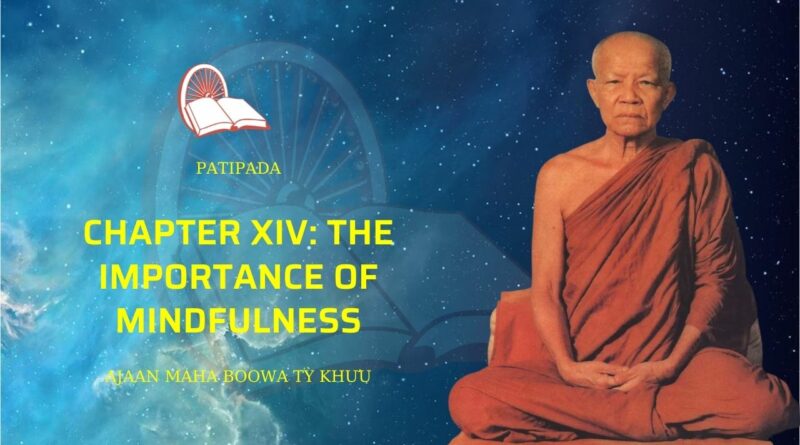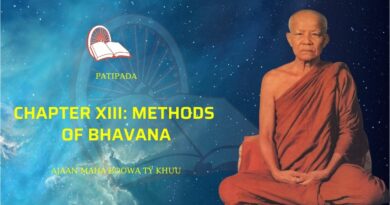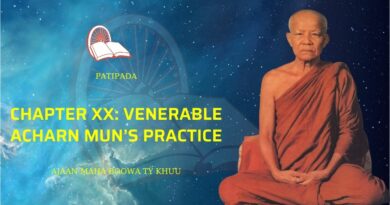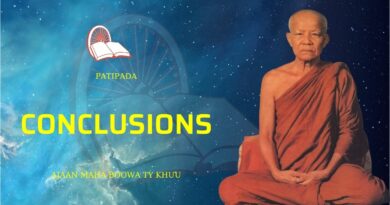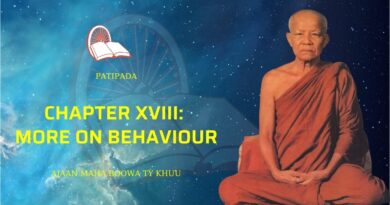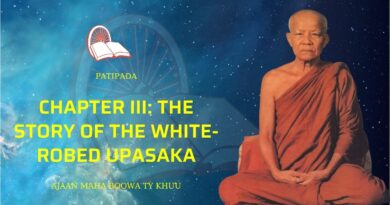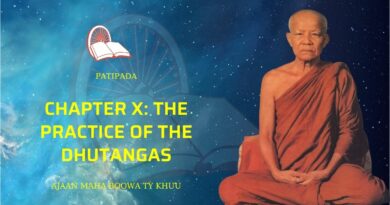PATIPADA – CHAPTER XIV: THE IMPORTANCE OF MINDFULNESS
Guarding the citta most of the time or the whole time, is the way to promote mindfulness and the citta so as to make it competent in the work of samadhi bhavana and in other kinds of work also. For then, whatever type of work is done, is done deliberately, with mindfulness to keep one’s attention on that work, and it will tend to be elegant and free from fault. As to oneself, one will not be a “playboy” wasting one’s life in dissipation, but a person or Bhikkhu who keeps within his level or status and does not act in ways that diminish his status and the standard of his work so that it becomes despicable. Therefore the saying that: “Mindfulness is desirable in all circumstances,” is correct and most appropriate and cannot be disputed. The necessity of mindfulness will come to be seen when one practises samadhi bhavana or one investigates Dhamma in all its different aspects. In work of this kind it is essential that mindfulness should go along with it at every moment in order that one may be able to know what is happening to the citta and Dhamma with enough precision for one’s purpose.
This becomes increasingly important for those whose “ground” of citta and “ground” of Dhamma are above the normal level; and right up to the highest levels, mindfulness is still an essential Dhamma every time and it cannot be dispensed with. In fact, whatever acuteness, strength and capability of wisdom one has, it depends on mindfulness to support it and promote it. So even if wisdom is about to reach the ground of “Great Wisdom” (Maha–Pañña) it gives an indication to mindfulness that it also must reach the ground of “Great Mindfulness” (Maha–Sati), because mindfulness is that device of Dhamma which leads the way in all kinds of work. Ordinary people like ourselves who are at times unmindful, display characteristics at those times which are unseemly and inelegant; and in those cases where they let go of mindfulness in a big way, as if they have lost all interest, it seems that the time has come for them to be taken off to an “institution” — for certain!
It is for the above reasons that those who practise the way and attain Dhamma, do so either slowly or quickly depending upon the strength of their mindfulness and wisdom which are very important, and this is true even allowing for differences in character. Therefore those who urgently drive themselves to develop mindfulness will soon find that samadhi appears and their thoughts and insights in the direction of wisdom will come much more quickly than otherwise.
It makes me think about the task of writing a book such as this one. For it becomes quite clear how, on a day when mindfulness slips and drifts about due to a lot of confused thoughts, one’s writing is full of mistakes, confusion and many corrections. But on a day when the heart is not confused and one has mindfulness present one’s writing is mostly correct and good with little need for any corrections.
Those who are well known and renowned for their abilities in the citta and Dhamma are generally those who have mindfulness and who are able to see the importance of it. So they try to establish mindfulness the whole time without letting their minds slip into forgetfulness. In particular, when they do samadhi bhavana as well as the investigation of all forms of Dhamma, their mindfulness and wisdom must blend into one another all the time, and they do not allow them to be present sometimes and absent at others.
Whoever acts and lives like that will have “Jagara Dhamma” — the Dhamma which wakes and arouses him to be vigilant — within himself wherever he goes and in whatever he does. He has a means of protecting himself which is strong and lasting, so it is difficult for an enemy to reach him and there is no danger to his heart. This is entirely different from those who are not mindful and who accumulate dukkha and however much they have they go on accepting it to the end.
Venerable Acharn Mun taught the need for mindfulness very frequently and most insistently, regardless of the type of practice being used, the posture, or whether it concerned someone who was just beginning or one who had done it for a long time. In all cases he was certain to teach the need for mindfulness along with other things to suit the level of citta and Dhamma of the person who came to learn from him. He said how he had seen the bad effect of being without mindfulness, as well as the virtue of having mindfulness present from when one first starts to put forward the effort to do the practice right through until one has reached the final goal. He also said how both of these were very important factors which one cannot afford to neglect — and to give confidence to those who practise the way, he said: “Regardless of age or sex, if those who do the practice have interest in and pay attention to mindfulness all the time in all postures and situations, and not in fits and starts, they should have the hope and expectation that the attainment of samadhi (samadhi–samapatti) as well as the Path, Fruition and Nibbana will not be beyond their reach.”
From the time when one first starts the training one should set up mindfulness as one’s constant companion and guardian. Then one’s sense of oneself, of the right and wrong and the good and evil which arise in oneself and others, whatever it may be, one will be able to know for sure, and this will steadily increase while one remains mindful. At the same time one will not let go into absent mindfulness, which would allow the kilesas to drag out and steal the good that is in one, and swallow the lot. If one can do this one should have firm hope and expectation indeed.
Yet generally speaking, those who practise the way of Dhamma turn and become those who blame Dhamma, saying: “It hasn’t given the results which it should,” or “it gives me no results when I do the practice.” Because those kilesas which led them into absent mindfulness, sneak in to take over the duty of mindfulness by getting in before mindfulness which should be the leader, and then stealthily take over the job of looking after the citta. This happens both when one is trying to strive at the practice and at all other times as well. This makes these people feel disappointed that they did not achieve what they thought they would. But instead of blaming themselves for losing out to the kilesas, they turn and blame Dhamma for giving them bad results, so they lose in all ways. This is the way of those Bhikkhus who practise without taking any interest in watching the kilesas which lead them into absent mindfulness, and this is the main danger, both to oneself and to one’s efforts to do the practice. This great boss (kilesas) thus gets the opportunity to remain with the one who does the practice quite openly, without him ever becoming aware that he has been “taken for a ride.”
If one is an observant person one will be able to know what has happened within a minute. For when one firsts starts to establish the practice, in any of the various ways of doing it, by setting up mindfulness in conjunction with the effort to do it, that is the time when one will be able to see how the setting up of mindfulness and the dispersing of mindfulness will fight each other, so that one can look at it and see what happens. Then before long the forgetfulness which disperses mindfulness — which is nothing but the kilesas intently watching and waiting — will win and drag the citta away and disappear with it. From that moment all that is left is the body of one who practises without mindfulness and void of effort. If he is walking cankama, all that is left is the mere activity of walking, if sitting in samadhi then he is merely sitting; and if he is standing to ponder Dhamma he is merely standing, just like a puppet or a doll. It is no good searching in him for the kind of effort which is put forth by those who practise the way truly, because mindfulness which is that factor in striving to practise which gives rise to results has been entirely consumed by the kilesa of carelessness. All that is left is the body which is merely going through the motions of striving, and nothing else. This is how the kilesas destroy people and destroy the efforts of those who practise the way. Their destructiveness takes place right in front of one’s eyes when one is fresh and conscious by lulling one into a deep sleep of forgetfulness even while one is actually striving to practise the way.
At any time it is quite possible to know how clever the various kilesas are, if one really wants to. Even when one is just beginning to work at the practice one can get to know this without much difficulty — but generally speaking one does not want to know. Instead, all one wants to know are the attainments of samadhi (samadhi–samapatti) and the Path, Fruition and Nibbana. But what can give rise to these states of Dhamma apart from mindfulness and wisdom which are the necessary tools for clearing the way? Certainly not careless indifference, so that one has no interest in being guarded against it, for this is what destroys all forms of Dhamma, such as the above, which one wants and hopes to attain.
Sometimes when Venerable Acharn Mun gave a talk on Dhamma, what he said was very funny and we who were listening could not help laughing inwardly. I can remember how funny it was, but the Dhamma that he was pointing out to us has almost gone now. He said: “If your heart was truly in your efforts to practise the way, like someone who is full of vitality and spirit, your heart would have a way in which it could develop and grow. Not like people getting into their coffins all the time as you are now. For whenever I look nowadays, all I see is scrap Bhikkhus and scrap Samaneras, like scrap metal, moving about and walking back and forth on the cankama path, sluggish and ungainly, without any mindfulness or awareness within them. As for any wisdom (pañña) or penetrating insight — if they are sitting in meditation, they merely sit there like scrap-iron men thrown away in a shop or a factory. But even scrap iron does not sway about nodding forward and backwards like a person dying in the pose of striving at the practice — which is most annoying to see. As for the Kammatthana Bhikkhu who sits nodding out of control, whether he falls down and dies or not it is enough to trouble others who have to recite the “Kusala–matika”. This is a sorry thing to see! And sometimes at night when the crows and dogs are all asleep, if anything happens, who will come and help to arrange things so that the corpse is given a traditional human funeral?
If this happens in day time, the vultures and crows will be troubled also, for when they come flying around thinking that some food is available, they see it is still breathing and fidgeting and they are afraid to come too close, so they fly away and perch on a tree to wait and watch. Sometimes they think: “This is it,” and they fly down to have a look at the troublesome object again feeling sure that they will be able to have a go at it this time. But as soon as they get close its mindfulness returns and it looks straight at them. So they are all afraid and fly away without much hope left. But once they have flown about the place to try and find something else to eat, they come back again. Because the appearance of this one who is trying to meditate is like someone who is half dead — as if telling the crows and vultures to come back again, saying, “It’s dead now, you can come and eat it.” This is how it acts all the time. It’s enough to make them irritated with this waste Bhikkhu who keeps changing his position. This is the way of one who practises and causes irritation to the vultures, crows and dogs, both domestic and wild. He not only causes irritation to them, but he will break the heart of the one who teaches him which is far worse than the trouble caused to the animals who are waiting to eat the meat and bones of this Bhikkhu when he dies because he has no mindfulness to support and lift him up at all. This is a kind of practice which is an endless preparation never stopping and never giving any results.”
At this point, Venerable Acharn stopped and rested for a short while and it seemed as if he was looking to see what was the state of mind of the Bhikkhus and Samaneras who were listening. When he saw that they were all sitting quietly and undisturbed, some afraid and some amused. Then he started speaking again, as if he was answering some of their unasked questions, saying: “How would it be to arrange a funeral service (Kusala–matika) for a Bhikkhu who is still alive? They have the merit making ceremony (Kusala–pamsukula) for those who are dead — if they don’t have the merit making ceremony to make merit for those Bhikkhus who sit in meditation and sleep as if dead even when they are still alive, won’t they all fall into hell? Even when they walk cankama or sit in meditation they sway back and forth as if they are about to jump down into hell while they are still alive. When the time comes for them to truly pass away, where are they going to jump to if not to the hellish abyss of perpetual sleep?” We who were listening had never heard of the “hellish abyss of perpetual sleep” previously, but Venerable Acharn revealed it to us at this time.
After the meeting, various groups would quietly gather together to talk for a short while before breaking up and returning, each one to his own place where he worked at his meditation practice — which Venerable Acharn had called a mortuary of half dead Bhikkhus preparing themselves for their funeral service. But, as I related earlier on in this book, it was strange how none of the Bhikkhus or Samaneras displayed any signs of irritation, of being upset, or of discontent with what Venerable Acharn had said in his castigating talk. For each of them heard this unusual and rather amusing talk on Dhamma with inward satisfaction and pleasure, hoping that he would not finish too soon. This was probably because of their complete faith in Venerable Acharn, that he was in a state of complete purity and that the ground of his citta was overflowing with metta. And for that reason none of them ever felt inclined to criticise him in any way. In fact, instead of being repelled by the rather morbid tone of his talk, it aroused their mindfulness to reflect and see how baneful and harmful it was to be forgetful and without mindfulness internally within each one of them.
While giving a talk of this kind, Venerable Acharn’s appearance and tone of voice were quite intimidating, but once he had finished he immediately returned to normal, as if he had never been like that at all. Those Bhikkhus who had stayed with him for a long time, so that they had learnt to know his characteristics quite well, would talk normally with him after such a Dhamma talk, as if nothing unusual had happened just a short while ago. But those who had recently come and had just begun the training, never having been exposed to such methods of Dhamma as Venerable Acharn used to correct and straighten their characteristics, would react in various ways when suddenly coming up against it in this way. Some would fidget and move about, others would become conscious of aches and pains, or of getting hot, or cold, without having enough mindfulness to be able to restrain themselves and be self-controlled. Like what happened when a dog was picked up and thrown onto the body of a dead tiger; it got so frightened, all it could do was to make grunting sounds, jump away and run for its life. What was unexpected was that it left part of itself spread all over the body of that tiger. But what was it that it left behind spread all over the tiger which had so frightened it? As for the dog, it had fled without restraint.
Generally those Bhikkhus who went to receive training under Venerable Acharn were, to begin with, rather like that dog, thrown onto the dead tiger. They did not have enough mindfulness to control themselves as they should, and standing, walking, sitting or lying down, they were always afraid that he would only criticise and scold them. But they did not think of the underlying reasons why he should do this, which are far more frightening than that dead tiger was to that dog.
But those who had been under training with Venerable Acariya for a long time, the more he scolded them the more it became like a remedy which quickly cured their sickness. And no sick person is going to get angry and resentful with the doctor who quickly gives him some medicine to help him overcome that sickness which is bearing down on him so that he cannot save himself. Instead, he is likely to be grateful and thankful towards the doctor who can find a way to save his life, which he, the doctor, does because he has the Metta to give help to others.
Those who practise the way and see the danger of being stupid — which is due to their own kilesas bearing down on them and piling up against them will be happy and smile with contentment at such strong yet kindly teaching. This teaching which is given with the aim of curbing and curing their own kilesas; and it comes from an Acariya whose citta is full of metta and thoughts of helping others in all sorts of ways to get free from, to avoid and evade the kilesas and a mass of suffering, and not to give way, lie down submerged and defeated, completely subject to the power of the kilesas which always bear down and force one towards destruction and ruin.
Listening to Dhamma Talks From the Teacher
When one listened to the Dhamma teaching of Venerable Acharn, if one listened for the sake of Dhamma and truth, opening one’s heart to its deep knowledge and true reasoning, without holding oneself back to let the kilesas of conceited opinions (ditthi–mana) obstruct and influence the Dhamma which he revealed, then one would hear Dhamma that went to one’s heart. This Dhamma could cure the kilesas one after another like going straight up steps, in a manner which one realised quite clearly in one’s heart while listening to him each time he gave a talk to us. In particular, if something happened to surprise or stir him such as a chance event, or something connected with one of the Bhikkhus, he would seize this as an opportunity to set it up as an example to reveal Dhamma then and there. At such times what he said was much more valuable to the listener than those more normal occasions when he gave a talk. Those who tended to be afraid of Venerable Acharn would become so full of fear as to be almost out of their wits. But those who were more intent on reason, truth and Dhamma got this in full measure depending on their own ability in mindfulness and wisdom.
The Dhamma which came from Venerable Acharn at such a time was not like anything that they had previously heard. But it was absolutely appropriate to that occasion without repeating the pattern of anything he had said in the past. Because it was a characteristic of Venerable Acharn Mun’s way when revealing Dhamma that he would not normally repeat lines of talk which he had already used in the past. Even those old sayings and proverbs which he may have used before, when he brought them up again he would interpret them anew without repeating his former explanation. Although his meaning may be close to what he had previously said it still acted as a skilful method which we who were listening to him could use, and we could not help but admire his skill time and again. It showed that the research which he had done within himself was in accordance with what is called “True Patisambhidanusasata”.
Those who had stayed with him for some time grew more and more to like that Dhamma of Venerable Acharn’s which was forceful, strong, impressive and rousing, much more than they liked his normal, milder approach, because its “flavour” was so unusually impressive. But those who had never before heard such Dhamma would think that he was scolding them and they would become frightened to the point where they would forget to pay attention to the truth of his reasoning at that time. So what they got out of listening to his Dhamma was entirely different, almost as if there had been two separate Dhamma talks although in fact both groups heard it at the same time.
When Venerable Acharn taught Dhamma to those Bhikkhus who practised the way and were close to him, he would teach in a manner that went directly to the truth of causes and their effects without mincing his words or wrapping them up nicely. He would range through all the levels of samadhi, all the grounds of wisdom and all three of the Ti–Lakkhana. Whatever things he was dealing with, he would bring them to life, clear the way and reveal them as they are for those who were listening, in a manner which went right to the heart. This was most appropriate to those Bhikkhus whose hearts were skilful in every stage of citta bhavana — but the one who is writing cannot reveal everything that he said, for this Dhamma was just between Venerable Acharn and the one who was receiving it. All that can be said is that it was Dhamma of the type that is “very hot and spicy” — which frightened the kilesas and drove them away in large numbers because of the power of this “Austere (Tapa) Dhamma” which scorched them and drove them out and away from his remarkable or miraculous teaching (anusasaniya–patihariya) like water being dried up by the sun. It was as if one could see all the clans, families and relatives of all the different types of kilesas being broken up and forced to disperse in disarray without retaining any semblance of order, at that time.
It is said that when the Lord Buddha reached the end of a Dhamma talk, some or many of his faithful followers penetrated the exalted Path and Fruition Dhamma from the lowest level of the Ariya Dhamma up to the highest level. In this present age, although the type of Dhamma talk of the kind which reveals the elements of the worlds (loka–dhatu) which Venerable Acharn Mun taught to the circle of Bhikkhus who were practising the way may be only an insignificant shadow in comparison with what the Buddha taught, yet when the writer compares them together to assess the truth of the above assertion, he cannot help but have complete faith that what is said to have happened after the Dhamma talks of the Lord Buddha is completely true. Those who say he is gullible and believes too easily may say so, but those who believe will continue to believe what we have written. For the kilesas are a true and genuine factor in the Noble Truths (Ariya–Sacca) and the Dhamma which cures and overcomes these kilesas is also a true factor in the Ariya Sacca. When the (second) truth reaches the (first) truth in full force, the citta is bound to experience a manifest result every time and everywhere that it happens, in everybody without exception.
The Lord Buddha taught the truth of Dhamma and Venerable Acharn Mun also taught the truth of Dhamma, for the purpose of curing the kilesas which truly exist and have always done so in every age and time in the same way as they do now. Therefore, whoever may give such teaching, the loss and dispersal of the kilesas which occurs due to the Dhamma teaching which washes and cleanses them out is valid as far as reason is concerned. One should not object to this, because both the kilesas and the Path (Magga) do not depend on anything except only on the acquisition and accumulation of the kilesas and the curing of the kilesas — that’s all. It is like a thing or a place which is filthy, the cleansing of it depends only on its being washed with clean water.
While listening to Venerable Acharn Mun giving a Dhamma talk, those in particular whose cittas had reached the ground of wisdom should have been in a fit state to be able to analyse and see the implications of what he said while following the lead given by Venerable Acharn. This means seeing clearly while wisdom is destroying the kilesas by relying upon Venerable Acharn’s Dhamma to prepare the ground. Those who were listening and analysing following Venerable Acharn’s lead would therefore at the same time be curing the kilesas bit by bit accordingly. By listening, analysing and curing some of one’s problems this time, and then listening to another Dhamma talk in the future, doing further analysis and making further inroads into the kilesas, and by going on in this way many times they must surely be able to get through the thick jungle of the kilesas and go free. Therefore those who do not want to let others believe that listening to a Dhamma talk can lead to the penetration of the Path and Fruition, would seem to be making an exhibition of those kilesas which they have been fond of displaying in the past. For normally, the kilesas do not like reason, but rather, they like making a display of self and flattering their owners that they are clever — even though they are not clever, and even though those who truly are clever and wise and far more senior, keep on blaming them and remonstrating with them all the time.
The hearts of those who were training in the basis of samadhi — a state of calm, would, as soon as they heard Venerable Acharn’s Dhamma, drop into a state of calm much more easily than when they were doing the practice on their own, because his Dhamma would pacify and soothe them while they were listening. So listening to Dhamma is a practice that is an important branch in the whole field of striving to practise the way.
As for those who have never done any practice and never listened enough for any results to become apparent, if they want to go their own way and follow their own understanding, they are free to do so. But in truth and in accordance with what is valuable and useful, this is not the way to gain anything of any use at all. All that is likely to come from it is defilements which stain the name of Buddhism, causing disheartenment to those who have set themselves to practise the way and making them fed up with this sort of thing, so that they laugh inwardly while saying to themselves: “This clever genius thinks he’ll become enlightened by his opinions and opposition to the true way!” For they brush aside and dispense with the Path, Fruition and Nibbana saying: “We should leave it alone as being only within the power of other people in other ages and places.” But for themselves, they just swallow the emotional attitudes of opposition and opinionatedness which becomes the ground of their hearts.
When an Acariya, one who practises the way, asks his followers, just after he has given them a Dhamma talk, saying: “While listening to this talk did you get any sense of it, or not?”; he is asking them whether they got a sense of calm and peace, or whether they got any insight in the way of wisdom, respectively, depending on the ground of their citta and Dhamma which is different in each one of those who were listening to his Dhamma talk. He is not asking them whether they took note of and remembered the meaning of the Dhamma which he revealed, although some of it might have dropped into their memories, which they could then easily recall. But it is not at all necessary to be able to remember or recall whatever has slipped away, for the important thing is to set one’s citta to attend with present awareness right there while listening and not forgetfully slipping away to other seductive and emotionally charged topics, but having mindfulness to accompany the citta with the duty of maintaining inward self-knowing. The flow of Dhamma which the Venerable Acariya is revealing will then enter and make contact with this knowing which has already been properly established and one will hear clearly and listen to every word, far more so than sending the citta outwards to receive Dhamma.
The citta and the flow of Dhamma with which it makes contact and acknowledges, not in fits and starts but steadily and continually can lull and soothe the citta causing it to become calm and unwavering, and to drop into samadhi. Then while listening, other emotionally charged sense stimuli do not intrude and cause trouble, nor does the citta go out and become involved with external things which arouse interest, which agitate the heart making it dull and inert. So there is just the citta and Dhamma in contact with each other and the citta will tend to become calm by itself.
Once it has become calm there will be no more enticing thoughts and imaginings to cause disturbance and one tends automatically to forget one’s tiredness, aches and stiffness as well as the passing of time. In fact it seems at this time almost as if one did not have a body, for all that remains is the resulting peace and calm, letting the citta drink of the best nutritive essence rather than the other thoughts and sensations to which it is attached (arammana).
While the citta and Dhamma are intimately associated together as one entity there will be no weariness, irritation or boredom for however long it may last. For, as long as the citta does not withdraw from this state of calm, the body will not be troubled with any painful feelings nor will the citta be bothered by emotionally biased objects and situations (arammana). The heart and Dhamma will then be together with each other, dwelling in a state of calm and peace for they have never been antagonistic to each other since the beginning of time. But as soon as any other, emotionally biased object or state arises and becomes manifest it arouses antagonism. Then the body feels weary, the heart becomes irritable, sleepiness grows strong and one’s flesh, sinews and bones in various parts of the body start to give rise to aches and pains which rapidly spread everywhere, as if its parts are going one after another into a state of decay. Because those kilesas which are the basis of laziness tend to go around the various parts of the body, disturbing them and inducing them all to ache and pain and give trouble. Finally, the effort to practise breaks up and becomes incoherent, diffuse and half-hearted in an incompetent way, because this is in fact just what it is.
This is the story of the kilesas and all kinds of them work in the same way. They all lead people and other beings to harm and destruction whatever type they may be. So they are called “Mara” — the Evil One. If there are few of them they cause trouble and damage in a small way, but if they are many they cause much trouble and much destruction. They are in opposition to Dhamma, which is the one that helps, supports and promotes us in all ways that are good. The more Dhamma a person has, the more it will tend to make his heart calm and peaceful, and he can go on gaining more and more Dhamma until his heart is entirely Dhamma. Then he will have changed entirely and become Dhamma throughout. Such are the ones who are entirely possessed of Dhamma and possessed of supreme and eternal happiness.
When Venerable Acharn Mun used to ask whether we had got the meaning of a talk on Dhamma that he had just given, the above explanation is what he meant. Starting from a state of calm and happiness while still listening, right up to a state of brightness and clarity in wisdom that can enable one to get rid of some of the kilesas each time, depending on one’s own ground or level. This is what he meant by “getting the meaning” while listening to a Dhamma talk. It may happen many times until one can finally reach the end of the kilesas and know all Dhamma at that moment, and this is what he called “getting the whole meaning”.
Generally speaking, the Dhutanga Kammatthana Bhikkhus listen to Dhamma and “get the meaning”. They set up the intention to “get the meaning” where the heart and Dhamma come together and the result of this is a state of calm and clear seeing which arises in the heart. As for remembering the gist of the Dhamma which was revealed in the talk, they do not consider this to be so important as keeping their attention firmly fixed where Dhamma and the heart come together. Because of this, however many of them are sitting and listening to the Dhamma talk, they are so still it seems almost as if nobody is there. For each of them has fixed his attention to listen in his own heart, and each one is just like a tree stump, motionless, without any sign of fidgeting to show that he is tired or bored and has had enough. The only sound is that of Venerable Acharn who is delivering a concentrated form of Dhamma which puts one in mind of a heavy thunderstorm with hailstones and high winds blowing and gusting about this way and that. At this time it also seems as if all the kilesas and evil kamma would be blown away and destroyed by the blast flowing from the Dhamma. Because while listening with fixed and firm attention to the meaning, not one of the kilesas is going to show its face and open its mouth to display its conceit and arrogance while mindfulness and wisdom are cutting them down and chopping them to pieces with all their strength. All that remains is Dhamma which externally is the sound of Dhamma, and internally is the heart immersed and infused together with Dhamma as one, with nothing but joy and happiness accompanying the calm and peaceful Dhamma which is experienced arising in the heart.
Each time, the Dhamma talk would last three or four hours, after which, if any of us had any problems that were appropriate, we could respectfully ask the Venerable Acharn to help and point out the solution to the problem until it was well understood. After this we would disperse, each one returning to the place where he was staying. Some would then go to walk on their cankama paths to ease the stiffness from sitting a long time and to remove the kilesas from their hearts, using whatever method in which their mindfulness and wisdom is strong and capable of practising. They would probably go on walking for several hours before stopping and going to have a rest. But on those days when there is a Dhamma talk, the time when they leave off to take a rest is much later than usual, because they consider that they are special days and special occasions. So some of them decide to maintain their striving only in the three postures of standing, walking and sitting until dawn, without lying down and sleeping.
There are two reasons why they do not lie down and sleep at night. The first is because they want to struggle and make great efforts in their striving, as a way of paying homage to the Dhamma which Venerable Acharn revealed with great metta in the most heartfelt way right through from beginning to end. For after listening, faith would arise and increase, giving them the will to struggle, to try to do, and to follow what he taught with such metta. The second reason why they take no sleep is because they have absorbed the Dhamma of Venerable Acharn very deeply and the flavour of Dhamma which remains in their hearts is what has opened up their hearts.
The extent to which each of them absorbed Dhamma in their hearts, varied in accordance with the ground or basis which each of them have in their hearts. Some of them have a weak basis of samadhi, some have a more subtle basis, and some of them have a very subtle and intimate ground of samadhi. But each level brings enough of the bliss (piti) of Dhamma to enable them to absorb it joyfully in accordance with the level of each one’s ground. In addition, some of them would begin to train themselves in wisdom (vipassana–pañña) in a weak way as accords with their level of samadhi; some would be analysing with wisdom (vicara–vipassana) more strongly; some would be developing wisdom higher and higher; and some would be developing wisdom at that level where it has become automatic. This is when mindfulness and wisdom, incessantly go around and about everywhere with various kinds of Dhammas that come into contact with the heart without letting up nor letting go of them. If one likens it to the falling rain, it would be like a heavy downpour going on all day and night incessantly. Or, if one likens it to water, it would be like a spring which flows all the time in both the rainy season and the dry season. But in the case of Vipassana–Dhamma, it is referred to by its characteristics and called by the “forest” name of “Automatic mindfulness and wisdom.”
But if one wants to call it by its original name which they used at the time of the Lord Buddha, then it was called “Maha Sati and Maha Pañña,” so it should not be lacking in valuable properties. For mindfulness and wisdom at this level perform their functions at maximum capacity the whole time without stopping, hesitation or being sluggish. Nor do they need any coercion or force, unlike the more usual types of mindfulness and wisdom; for they know their job and they know their duty in full measure. But to call it Maha Sati and Maha Pañña as they did at the time of the Lord Buddha would be against the nature of those Bhikkhus who live in the forest who are afraid of making out that they are the equal of those at the time of the Lord. So instead, they just call it “Automatic mindfulness and wisdom” — which would seem to be quite appropriate to their level and characteristics.
These are the Dhammas which lead the Dhutanga Bhikkhus to become fascinated and absorbed in their striving so that they lay down and sleep very little. Each one of them becomes absorbed in Dhamma in his own way, depending on his ground or level, and when any doubts or problems arise, some of them are not bold enough to go and ask Venerable Acharn about them at normal times. But on a day when a meeting is called they feel as if they could jump over the moon, because they are so glad to hear a talk which will clear the way and show them how to develop those points which they have been thinking about and analysing; and will also clear those problems which they were doubtful about so that they can go ahead step by step.
Each of them gets prepared and sets up a state of zeal, waiting ready to receive the cleansing Dhamma from Venerable Acharn Mun as if they had been waiting years for it. So when the time comes they gather at the meeting place in a calm, modest and graceful manner which should arouse much respect and faith in anyone who saw it — a thing such as is rarely seen elsewhere. Each one of them goes to the meeting intent on the purpose of Dhamma and with a determination to hear Dhamma which goes to the heart and each of them pays obeisance by prostrating before sitting down politely while waiting to hear Dhamma.
As soon as he is ready, the Acariya who is giving the talk begins to reveal Dhamma. Quietly and gently it flows out, steadily, without breaks, like rain when it starts to fall drop by drop. But, before he begins to talk he calms down any turbulence of mind that may be present for a short while. I think and believe that he was probably determining what aspect of Dhamma he should deal with which would be suited to those who were waiting ready to listen to him. It was after this that he would begin to reveal that Dhamma which he taught only to the Dhutanga Bhikkhus. Generally speaking he would start from the level of samadhi and then go on to wisdom, finally leading to the highest level of Dhamma — Vimutti, Freedom — and then finish. While he was revealing Dhamma there were no disturbing sounds at all, but only the sound of Dhamma that he was proclaiming which resonated around the place where they had met together. Those who were listening, were doing so with interest, waiting to know and wanting to see accordingly, in conformity with Venerable Acharn’s teaching, fully committed and wholeheartedly. Not slipping away into forgetfulness and distraction so that the citta ran away elsewhere, but keeping their attention fixed firmly looking at the heart alone, which is worthy of Dhamma at all levels.
In this way, the Dhamma which the Acariya reveals and the heart which is set, ready to accept it properly, are both suitable and appropriate for experiencing all sorts of things to enter, make contact and get involved with the heart. Whether he talks of the Noble Truths, Satipatthana, or the Ti–Lakkhana — Anicca, Dukkha, Anatta — they are equally the truth and embrace the whole field of human beings and all other beings throughout the whole universe (Ti–loka–dhatu), which he reveals at that time. So it is like listening to the truth of the Universe flowing in and filling the heart which having been prepared to accept and know it in a fully committed way, makes them listen wholeheartedly. Because the Dhamma which goes back and forth, making contact with things both near and far, internally and externally while Venerable Acariya brought them up and displayed them is the Dhamma which helps in all ways in everything down in the body and the citta of those who can listen to it, and there is no way left for doubt to arise.
After listening to the talk which Venerable Acharn gave, with great metta and hearing about what is good and virtuous as well as what is bad and faulty, the heart of the listener which has in the past gathered, accumulated and guarded all the kilesas, thinking of them as being fundamentally good things right from the first beginning should be willing to let go of them and get rid of them, otherwise it means that his heart must have been much too blind, dull and closed. But who would deliberately set themselves to accumulate and shower more dukkha on themselves at such a time? Especially after they had determined to listen to the truth with full-hearted willingness, from their Acariya who reveals Dhamma that is wholly true? Rather, they would just be listening to his teaching which was true Dhamma, so as to see clearly what was faulty and what virtuous in themselves, following his talk. Then those things which were wrong and faulty should be willingly let go of whereas those that were virtuous should be held to and developed in accordance with the truth and their intention, this is the only way for them.
Therefore, those who listen for the sake of the truth of Dhamma which the Acariya is displaying in a true and valid way, have a means of “knowing” and of “getting rid of”, and this is the result that comes, and this result is their confirmation and guarantee. Diseases which are cured by medicines, and kilesas which are got rid of by Dhamma are both instances of natural processes which are used in the world and in Dhamma respectively. The exceptions are of course the disease which does not “listen” to the medicine and the type of kilesas which will not look at Dhamma. Wherever such a situation exists and arises it is bound to lead to ruin inescapably — so such people are said to be “beyond hope”.

